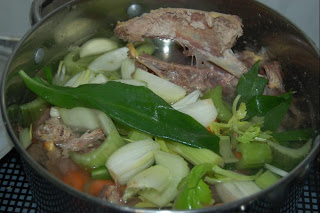
Waste nothing! Once you have stripped the meat from bones, don't throw the bones out. Make stock instead and avoid having to buy mass produced stock on sale at the supermarket.
The other point about making stock is that it does not have to use the best vegetables you have. Instead, you can use up old veg that really could have done with being eaten earlier.
The stock I made on Sunday used three pheasant carcasses, and a load of carrots and shallots that were past their best. I also found some celery in the fridge which was in good shape. Celery I find always goes down well in soup stock.
In addition I added a handful of wild garlic leaves.
To make the stock, add the bones or carcasses to a large pan. Chop and add the vegetables. There's no need to chop the wild garlic but don't worry about chopping the other veg too finely. Chunks will do.
Add the veg to the pan and cover the contents with water. For extra flavour I added a few sprigs of rosemary.
Then bring to the boil and simmer for about an hour. Then drain off the liquid into a separate pan or into containers if it is not being used immediately (in which case freeze it once it has cooled or put it in the fridge if you are expecting to use it within 24 hours).
If you can be bothered with the hassle, separate out the veg from the bones once you have strained them and use them as a base for soup. Again, it helps to cut down on waste.
We used some of the stock we made on Sunday for pheasant and wild garlic soup. For that you need:
1.5 litres stock
large handful of roast pheasant meat, finely chopped
2 medium onions, finely chopped
large handful of wild garlic leaves, chopped
herbs to taste (I used yet more rosemary)
Add the stock to a pan and add the ingredients. Bring to the boil and simmer for about 25 minutes, making sure the meat is cooked through again. Then serve and enjoy.
Again, we were pleased with this meal as it was mainly from sources that were foraged or hunted wild or grown on the allotment. Another small step towards self-sufficiency.